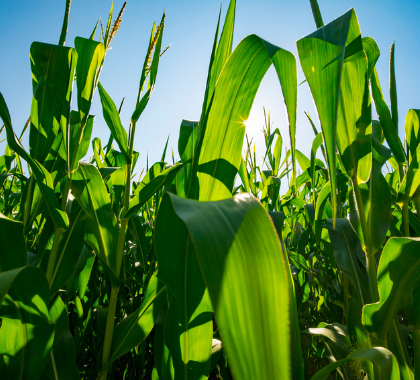Feeding the world’s hungry ranks among the greatest difficulties humankind has experienced throughout its history. With the Earth’s population expected to top nine billion between 2050 and 2100 (before starting a rapid decline), this challenge will likely worsen in coming decades unless people embrace increases in carbon dioxide and genetic engineering of crops.
Far from being an impediment to continued human existence, rising levels of carbon dioxide are part of the solution to world hunger.
The fact is, most plant life arose when carbon dioxide levels were much higher than they are today. During the most recent ice age, atmospheric carbon dioxide levels fell to dangerously low levels: just 180 parts per million (ppm). Plants begin to die when carbon dioxide is at or below 150 ppm, because at that point they are unable to use sunlight to photosynthesize food from carbon dioxide and water. After Earth emerged from the most recent ice age, carbon dioxide levels rebounded to approximately 280 ppm, still far below the levels existing when plant life began to colonize the land.
The addition of approximately 135 ppm of carbon dioxide to the atmosphere by humans—through the burning of fossil fuels, slash-and-burn agriculture, and various other actions—has helped reduce hunger immeasurably.
Since the widespread development and use of fossil fuels, world poverty and hunger have declined rapidly. Despite the addition of 3.2 billion people to the planet since 1968, poverty and hunger have plummeted at a faster rate than at any other time in human history. Although 840 million people worldwide are still undernourished, the number of hungry people has declined by two billion since 1990, according to the United Nations. Research shows there is now 17 percent more food available per person than there was 30 years ago—all occurring during the period of purportedly dangerous climate change.
The reason is not hard to find. The rise in the atmospheric carbon dioxide concentration has increased agricultural production per unit of land under cultivation by 70 percent for C3 cereals (such as rice, wheat, oats, cotton, and evergreen trees), 28 percent for C4 cereals (such as sorghum, maize, and various grasses), 33 percent for fruits and melons, 62 percent for legumes, 67 percent for root and tuber crops, and 51 percent for vegetables.
As explained in Climate Change Reconsidered II: Biological Impacts, as carbon dioxide increases, plant fitness and flower pollination improve, plants develop more extensive root systems to extract greater amounts of nutrients from even poor-quality soil, plants use water more efficiently by reducing the number and openness of stomata through which they lose moisture during transpiration, and plants produce greater amounts of of natural substances that repel insects and fight off competing weeds.
Thousands of experiments and the work of agronomists, botanists, farmers, and greenhouse operators worldwide show both crop and non-crop plants do better at higher carbon dioxide levels.
Fossil fuels are integral to the kind of large-scale food production that has proven critical to feeding Earth’s growing population. Gasoline- and diesel-powered tractors are used for planting, fertilizing, and harvesting crops and transporting and caring for farm animals. Gasoline- and diesel-powered trucks deliver crops to warehouses, store shelves, food pantries, and emergency shelters. Fossil fuels power irrigation systems and maintain climate-controlled storage facilities and refrigeration systems to keep crops from rotting and being devoured by pests. In addition, fossil fuels are the foundation of modern chemical fertilizers and pesticides that improve and expedite crop growth and prevent loss to weeds, insects, and other pests.
However, fossil fuels and the foreseeable levels of carbon dioxide probably cannot by themselves eliminate hunger and feed the world’s growing population calorically sufficient and nutritious daily diets. This is where genetically modified crops (GMC) come in.
Feeding Earth’s growing population will require industrial agriculture on steroids, with large farms producing 300 percent more food by 2050 and 500 percent more by 2100. Even if all land were equally capable of being used as cropland (which it isn’t) and we could find massive new sources of fresh water for crop production, substantially expanding the amount of land under active cultivation would be a disaster for wildlife and native plants. The reason for this is the lands most likely to be converted to agriculture are forests, rangelands, and other wildlands.
The most efficient, effective, and environmentally friendly strategy for feeding greater numbers of people is to farm land currently under cultivation more intensively by applying the best technologies, including high inputs of pesticides and fertilizers and broader use of GMCs.
Over the past 20 years, I have written extensively on the virtues of using bioengineering to improve crop yields and nutrition, to improve crop pest resistance, and to enhance plants’ abilities to grow and use inputs such as water and minerals in the soil more efficiently in the face of extreme climate and weather conditions. Those who object to genetic engineering are either misinformed—ignorant of the overwhelming body of evidence and science that has repeatedly shown the technologies to be safe—or are misanthropes, people harboring ill-will toward humanity.
In a recent article, Indian researcher Vijay Jayaraj eloquently discusses how genetically engineered crops, arguably the most thoroughly vetted products ever to be developed, are essential for solving the hunger crisis that still persists:
With the advancement of genetic technology, scientists now can achieve even greater improvements, with higher precision, in less time [than through conventional crossbreeding]. Many [GMCs] are scientifically tested, approved by the world’s top medical agencies, and declared safe by hundreds of Nobel Prize–winning scientists.
More than 100 independent, U.S., European, and international scientific societies have approved G.M. crops for their safety and recognize that they do not pose a risk to the environment or human health.
According to scientists, the benefits of G.M. crops include increased yield; improved quality; and adaptability to specific abiotic and biotic stresses such as drought, pests, and disease, among others.
A study that assessed the environmental effects of G.M. crops globally found that G.M. crop use reduced pesticide spraying by 352 million kilograms between 1996 and 2008.
G.M. variants of rice, maize, wheat, cotton, canola, potatoes, aubergines (eggplant), squash, soya beans, papaya, and sugar beets have already been approved and commercially cultivated in more than 185 million hectares across the globe.
People and wildlife around the world would benefit from the further development and wider use of GMCs. In addition, the greatest benefits would accrue to the poorest of the poor in Africa, Asia, and Central and South America, those areas where abject penury, hunger, and malnourishment still reign supreme across a large percentage of their respective populations.
Climate change, whatever its causes and effects, is not causing nearly as much human suffering today and for the future as do hunger and malnourishment and the ills they bring in their train, such as premature infant mortality and stunted physical and mental development. This has been true since the end of the last ice age and is likely to remain so until the next ice age arrives.
SOURCES: Cornwall Alliance; National Center for Policy Analysis; Roanoke Times; Nongovernmental International Panel on Climate Change; Climate Realism
IN THIS ISSUE …
CLAMS INDICATE PAST CLIMATE CONDITIONS WERE BETTER FOR THEM … GREENLAND WAS GREEN IN THE PAST WITHOUT HUMAN HELP
CLAMS INDICATE PAST CLIMATE CONDITIONS WERE BETTER FOR THEM
Since the end of the most recent ice age, clams in the rivers feeding into the Adriatic Sea beside Italy have thrived during periods warmer than today, when sea levels were higher, new research published in the peer-reviewed journal PLOS One shows.
An international team of scientists from universities and research institutes in Italy (where most of the researchers were from), Amsterdam, France, and Israel writes, “Clams’ feeding activity, calcification rates, and overall shell density have declined in concert with decreasing sea surface temperatures and the long-term falling sea-level trend since the Holocene peak about 6,000 years ago.”
The researchers studied clam biology and numbers during several periods of the present interglacial (Holocene), including “two from the Middle Holocene, when regional sea surface temperatures were higher than today.” How much higher? The Earth’s surface temperatures were “up to 4°C” warmer during the Holocene Climate Optimum (HCO) between 9,000 and 5,000 years ago, when carbon dioxide levels were significantly lower than today’s, at approximately 265 ppm. Sea surface temperatures (SST) were also warmer than today, and sea levels were higher, such that many historic shorelines, coastal cities, and towns are now landlocked miles from present coasts.
The researchers found Italy’s longest river, the Po, expanded between 20 to 30 km seaward since the Mid-Holocene because of the cooling SSTs and expanding land mass. They estimate the Adriatic Sea was approximately 1.5℃ warmer 6,500 years ago and land glaciation is more extensive today than then.
Cooler sea surface temperatures and lower sea levels have resulted in the clams residing in Po’s waters developing in much cooler river temperatures (2 to 6°C) than previously. As a result, clams face an “increasing … metabolic cost for calcification” which is lessening their shell density, making the shells more fragile.
SOURCES: Climate Change Dispatch; Plos One
GREENLAND WAS GREEN IN THE PAST WITHOUT HUMAN HELP
New research shows Greenland has been much warmer in the past, with many areas being ice-free. Researchers just rediscovered and analyzed an ice core bored in the 1960s during the Cold War when a military base was developed there. Here’s what they found:
Deep ice … some 75 miles inland from the [present] coast and only 800 miles from the North Pole—entirely melted at least once within the last million years and was covered with vegetation, including moss and perhaps trees. The new research, supported by the National Science Foundation, lines up with data from two other ice cores from the center of Greenland, collected in 1990s. Sediment from the bottom of these cores also indicate that the ice sheet was gone for some time in the recent geologic past.
This research shows life thrived in Greenland wholly without any human influence, where now there exists only a frozen kingdom of ice. Although this particular study is new, its findings are hardly “discoveries.” Scientists have long known the globe has shifted between long glacial periods and short interglacial periods over the past million years. During previous interglacials, areas now under tons of ice were ice-free, coastlines were much farther inland, and seas were significantly higher, including in Greenland. Green ecosystems expanded and life thrived, only to be snuffed out across vast parts of the globe when the next ice age occurred.
“Our study shows that Greenland is much more sensitive to natural climate warming than we used to think—and we already know that humanity’s out-of-control warming of the planet hugely exceeds the natural rate” (emphasis added), one of the authors of the study told Science Daily.
“The new study provides strong evidence that Greenland is more sensitive to climate change than previously understood—and at risk of irreversibly melting,” Science Daily states.
In fact, this research shows nothing about “humanity’s out-of-control warming of the planet.” As Eric Utter writes in American Thinker, “Science Daily … drew exactly the wrong conclusions from the ‘stunning’ discovery. How can the fact that the ice sheet once melted away entirely, subsequently regenerated, and is still around today … be proof that it is at risk of irreversibly melting?!” (emphasis in original).
SOURCES: Science Daily; American Thinker





